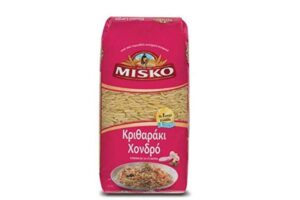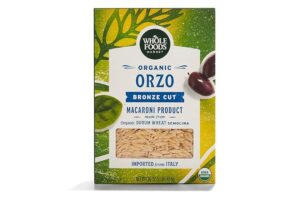If you enjoy starchy dishes, chances are you’ve come across risoni and orzo. The short-grain pasta is a staple in Italian and Mediterranean dishes. While almost similar, they have distinctive differences ranging from texture to size.

Whether cooking them separately or using them as an addition to other dishes, they no doubt bolster the flavor of your soup, stew, or salad. So, how can you distinguish risoni from orzo and vice versa? Let’s find out.
What Is Risoni?
Risoni, also called risi or pasta a riso, is a type of pasta that resembles rice. Often mistaken for orzo, it is slightly larger than orzo but smaller than rice.
It is made from a water, semolina, and durum flour mixture, which is kneaded into a dough and then rolled into small pieces.
What Is Orzo?
Orzo is a type of pasta popular in Italian cuisines. Somewhat similar to risoni, it is a thin, rice-shaped pasta made from a mixture of semolina, durum flour, and water.
It is classified as pastina, which is a category of small pasta. Like risoni, you can use it in many pasta dishes, grain bowls, soups, and other light dishes.
Risoni vs Orzo: Comparison Table
| Risoni | Orzo | |
| Term usage | United States | Europe, rest of the world |
| Size | Larger, resembling a large rice grain | Varies in size but smaller than risoni, almost resembling a barley grain |
| Texture | Smoother with rounded edges (plumper and chewier) | Rougher with an angular shape (smooth and tender) |
| Cooking time | 8-12 minutes | 8-12 minutes |
| Availability | Available worldwide | Available worldwide |
Risoni vs Orzo: Origin
While both originate from Italy, risoni is deeply ingrained in Italian culture and tends to be embedded in American culinary traditions more than orzo.
That said, you are bound to find it in most Italian cuisines. Whether in the north or south of Italy, people have found different ways to incorporate risoni in their dishes.
Orzo is more prevalent in Greece and has become a staple in Middle Eastern and Mediterranean cuisines. This makes it a more versatile option than risoni.
Whether you want to prepare it with lamb or other ingredients, you can never go wrong with orzo.
Risoni vs Orzo: Best Uses

Although risoni is mainly used with soups, it is also ideal for stews and salads. You can combine cooked risoni with pine nuts, lemon juice, garlic, olive oil, and parmesan.
You can also prepare it with capsicum or eggplant, fresh herbs, zucchini, and tomatoes then bake it for best results.
In short, you can use risoni in salads, soups, and stews. When using it in salads, precook it for eight minutes in salted boiling water.
For stews and soups, you don’t need to precook it. Just add it to the saucepan eight minutes before you finish cooking the sauce.
Cooking orzo is similar to risoni. Bring salted water to a boil and then add your orzo. Let it cook until it reaches al dente, which is approximately 8 to 10 minutes.
After draining the excess water, you can add your favorite flavor such as butter or olive oil. Speaking of olive oil, it comes in handy when using orzo with salads. Adding it while the orzo is still hot prevents clumping.
Alternatively, you can cook orzo as you would conventional rice. A two-to-one ratio of water to orzo is the rule of thumb. This will result in a creamier orzo since all the starch will be retained.
Like risoni, you can use orzo in several recipes. You can add it to salads, prepare it as risotto, or serve it as a side dish.
Risoni vs Orzo: Texture
When cooked, Risoni is plumper and chewier than orzo. This makes it an ideal option for heartier dishes, contributing to a satisfying mouthfeel.
Its chewy texture makes it stand out amidst other ingredients. This makes it an ideal option for salads and soups.
Orzo on the other hand is smooth and tender when cooked. And since it is smaller than risoni, it adds a more delicate mouthfeel that is less robust than risoni.
So, if you are preparing dishes with a lighter touch, orzo could be your best bet.
Risoni vs Orzo: Storage
To extend the shelf life of risoni, orzo, or any other pasta, you need to store it in a cool, dark place. A dark cupboard is good for risoni or orzo.
If you want better storage, you can transfer the pasta from its original packaging to an airtight container. This will keep off white-eating pests such as pantry moths. A mason jar would be an ideal option.
If you’ll be using fresh risoni or orzo, you’ll need to consume it within days of purchase. You therefore don’t need a mason jar or special container. Most fresh pasta comes in airtight packaging, which is enough to keep it fresh.
However, you should store it in the coldest section of your refrigerator. A freezer can be an alternative option. Just wrap the risoni orzo in a double layer of aluminum foil. This will prevent freezer burn.
Storing cooked pasta is somewhat similar to storing fresh risoni and orzo. You should let the cooked pasta cool to room temperature before placing it in a container. Store it in your refrigerator for 3-5 days.
Reheat the pasta by microwaving or steaming. You can add a bit of water to restore moisture.
How Long Can I Store Risoni and Orzo?

Risoni and orzo, when stored properly, have a relatively long shelf life. An unopened package can maintain its quality for one to two years.
An opened package can last several months if stored in a dry place away from direct sunlight.
When assessing freshness, check for signs of wheat-eating pests, discoloration, and off-putting odor.
Cooked risoni or orzo should be refrigerated for three to five days. Frozen pasta can last up to three months.
Can I Substitute Risoni for Orzo in Recipes?
Yes, you can substitute risoni for orzo and vice versa in recipes. Keep in mind the difference in texture and cooking time. It might be subtle but it may affect the flavor of your dish.
Also, consider the absorption of flavor as risoni tends to outshine orzo.
Think about the dish you are preparing. Is it a hearty stew or soup? Perhaps a lighter salad? If the former, risoni should be your best bet. The latter can be done with orzo due to its smoother texture.
Final Thoughts
Similarities between risoni and orzo make them versatile options for different dishes. While you can substitute risoni for orzo and vice versa, risoni is ideal for soups or stews while orzo excels in lighter salads.
The cooking time is however similar.
Of the two, orzo is the most popular, present in dishes globally. Risoni is mostly used in the Americas.
Both originate from Italy but orzo is popular in Middle Eastern and Mediterranean dishes. Use risoni if you want plumper and chewier pasta. For smooth and tender cooked pasta use orzo.
